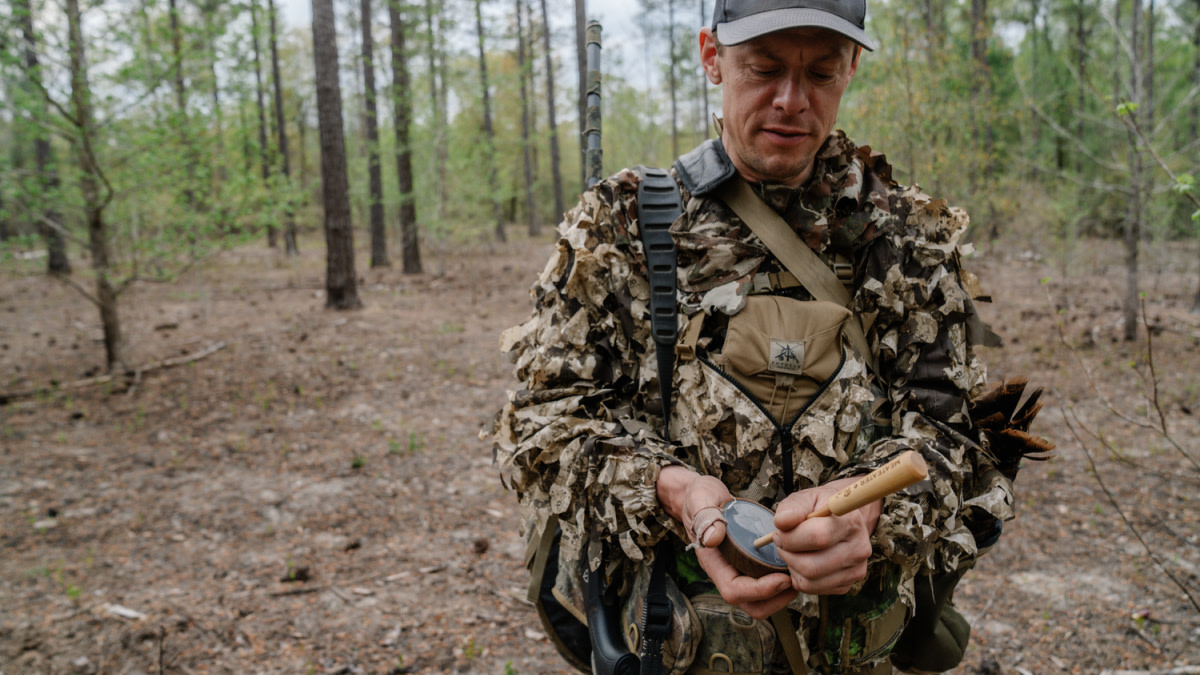
With enough time in the woods, you’ll eventually meet that one gobbler who keeps his beak clinched to one style of call but then turns suicidal following a few yelps from another. Frequency, volume, and pitch matter when trying to unlock what sounds sexy to a longbeard. And you need numerous options in your vest to help deliver exactly what he wants to hear. Here’s what you’ll find in mine along with the scenarios when I reach for them.
The Box Call Most turkey hunters, me included, scratch out their very first yelps with a box call in hand. The wood-on-wood friction of the paddle swirls and resonates in its hollow box, delivering some of the most natural sounding yelps in the forest with minimal expertise on the part of its handler.
I carry one in my pack–not for its bright tone and ease of use–but for its volume. The box call can slice through wind and dense vegetation that inhibit a gobbler’s ability to hear you.
The first turkey I ever killed solo succumbed to the piercing shrill of a box call in these conditions. Gale-force winds and dense cottonwoods along a Montana creek bottom necessitated the added auditory reach the box provided. While I never heard him gobble above the roar of the prairie wind, he appeared in full strut in search of the box call’s sweet, natural sound.
Additionally, the box call is a great tool for prospecting large open areas of the West as a distant locator call, where range and volume can traverse terrain so your boots don’t have to.
Like all turkey calls, the box call is not without its drawbacks and limitations. They require two hands to manipulate, making undetected close-quarters calling on a suspicious tom nearly impossible. Since the box relies on friction, most traditional designs perform poorly in damp weather and become unusable in rain. Additionally, while box calls excel in producing natural yelps, clucks, and cuts with attitude, in my opinion they struggle with realistic renderings of the softer or more delicate vocalizations in the turkey’s vocabulary.
The Pot Call The scratching of a wooden striker over a slate surface harkens back to the days of paper shotshells chambered in your grandfather’s 16 gauge. There’s no sweeter man-made sound anywhere in the turkey woods.
While mastery of the pot call requires more effort than the box call, it remains an exceptionally user-friendly device capable of a wide range of turkey sounds. The principles behind the pot call haven’t changed much–it still relies on the simple act of creating friction between a striker and its base–but the materials and technology certainly have. These advancements have given turkey callers an edge in pitch and volume while maintaining the pot call’s savvy for traditional delicate work like purrs and soft clucks.
I run a small variety of these in my vest for added volume and for another frequency option to offer a stubborn longbeard. One particularly recalcitrant Eastern gobbler residing in Washington State’s rainy west coast fell victim to the crystal-over-slate variety.
While he’d casually acknowledge suggestive advances from my mouth call, his attitude changed entirely when I launched a series of sharp cuts from the pot call. To this day I’m not sure exactly what I said that made him break ranks with the flock and meet his demise in that Pacific Northwest jungle, but I’m convinced he did so because of how I was saying it. The sharpness of that pot call flipped his switch for the last time.
Like the box call, most pot calls are sensitive to any humidity or moisture that limits the friction between the surfaces. While the pot can be anchored to a mount and affixed to your thigh or other stationary object to free a single hand, it’s far from a hands-free call. Movement is still required to create sound, limiting its utility in close quarters.
The Diaphragm Call If forced to choose a favorite call in my pack, I’ll reach for a diaphragm every time. While the learning curve to minimum proficiency is steeper than the previous calls mentioned, it’s a versatile and deadly tool when effectively deployed.
Personally, there’s some appeal in the challenge of learning a mouth call and the opportunity to create a unique, individual voice to entice a gobbler. While I have no data to support that it helps me kill more turkeys, I do find it markedly more fun to intersperse my yelps with intermittent cuts like an excited hen.
For close quarters calling, there’s really no equal in anyone’s vest. The diaphragm can whisper contentment clucks and purrs like a natural hen and deliver a soft tree yelp to a roosted gobbler with no more movement than a few puffs of breath over the call. It can also deliver natural yelps at a decent volume when required. In addition to being light, mouth calls come in a variety of configurations for pitch and tone. Callmakers have experimented with various materials and “cuts,” which are geometric variations on the top reed that enhance vocal qualities like rasp and tone. Just like turkeys, no two sound exactly alike.
Most hunters consider the steep learning curve to mastery the diaphragm’s biggest limitation, and I share that sentiment. I’ll add that mouth calls can struggle in windy conditions, prospecting, or in situations where distance and volume are needed to reach the ears of a distant gobbler.
Regardless of your choice for a go-to call, don’t discount proficiency and context as two critical pieces to success. With any of these calls, practice is required. Not only does the gobbler’s other-worldly knack for survival provide endless opportunity to hone your woodsmanship, but part of the sport’s appeal lies in the continual pursuit of fluency in turkey talk.





